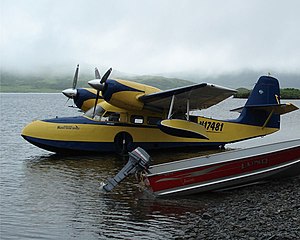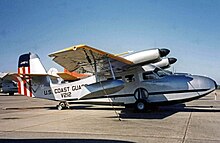Grumman G-44
| Grumman G-44 Widgeon | |
|---|---|

|
|
| Type: | twin-engine amphibious aircraft |
| Design country: | |
| Manufacturer: | |
| First flight: |
June 28, 1940 |
| Commissioning: |
February 21, 1940 |
| Production time: |
until 1949 |
| Number of pieces: |
345 |
The Grumman G-44 Widgeon ( German wigeon ) is a twin-engine amphibious aircraft produced by the US manufacturer Grumman Aircraft .
History and construction
The commercial success of the Grumman G-21 Goose and the need for a smaller and cheaper variant were the impetus for the construction of the G-44 Widgeon.
The Widgeon prototype was tested on June 28, 1940 by Roy Grumman and Bud Gillies in Bethpage, New York . On February 21st, the first series machine of a planned 44-piece series block was delivered. Four of them were requisitioned by the United States Army Air Corps (USAAC), where they were given the designation OA-14. The second production block was reserved for the US Coast Guard , where they were given the designation J4F-1. 131 copies of the improved J4F-2 were delivered to the US Navy between July 1942 and February 1945 . It served as a five-seater commercial aircraft for the coastal patrol and anti-submarine defense .
15 J4F-2 were awarded to the Royal Navy , where they were initially given the name Gosling, but later used the US designation again.
Grumman presented an improved G-44A in 1944, of which another 76 copies were delivered by January 1949. In France, 41 G-44A machines were built under license under the name SCAN 30 in La Rochelle by the Société de Construction Aéronavale (SCAN). Many Widgeon were upgraded in later years with more modern engines of the type Continental W-670 or AVCO-Lycoming 90-453A. McKinnon Enterprises carried out a conversion to the Super Widgeon, of which more than 70 pieces were completed. This model had better AVCO Lycoming GO 480 B1D engines with 201 kW (270 hp) as well as improvements to the hull structure and a greater range.
production
Construction figures for Grumman Widgeon:
| version | 1940 | 1941 | 1942 | 1943 | 1944 | 1945 | 1946 | 1947 | 1948 | 1949 | TOTAL |
|---|---|---|---|---|---|---|---|---|---|---|---|
| XG-44 | 1 | 1 | |||||||||
| G-44 | 34 | 9 | 43 | ||||||||
| J4F-1 | 8th | 23 | 31 | ||||||||
| J4F-2 | 17th | 56 | 44 | 7th | 124 | ||||||
| XG-44A | 1 | 1 | |||||||||
| G-44A | 29 | 36 | 7th | 3 | 75 | ||||||
| SCAN-30 | 42 | 42 | |||||||||
| TOTAL | 1 | 42 | 49 | 56 | 44 | 37 | 36 | 7th | 3 | 42 | 317 |
Military users
- United States Army Air Corps
- United States Army Air Forces
- United States Coast Guard
- United States Navy
Incidents
- On May 22, 1956, a Pacific Western Airlines Grumman Widgeon ( aircraft registration CF-GYZ ) crashed into Eagle Bay near the destination Kitimat ( British Columbia , Canada). All 3 occupants, the pilot and the two passengers, were killed. They were on a flight search for a fisherman who had fallen from his boat.
Technical specifications

| Parameter | Data |
|---|---|
| Type | Amphibious aircraft |
| span | 12.19 m |
| length | 9.47 m |
| height | 3.48 m |
| Empty mass | 1447 kg |
| Takeoff mass | 2041 kg |
| Engine | two six-cylinder in - line engines Ranger L-440 C-5, each 149 kW (approx. 200 hp) |
| Top speed | 246 km / h at an altitude of 1330 m |
| Range | 1481 km |
| Service ceiling | 4450 m |
| Armament | no |
Web links
Individual evidence
- ↑ Knight, Fred J .: The Grumman Amphibians - Goose, Widgeon & Mallard, Dorchester 2013
- ↑ Air-Britain Archive: Casualty compendium part 67 (English), December 1997, pp. 97/111.
- ↑ Joe Baugher: USAF serials , accessed February 4, 2020.